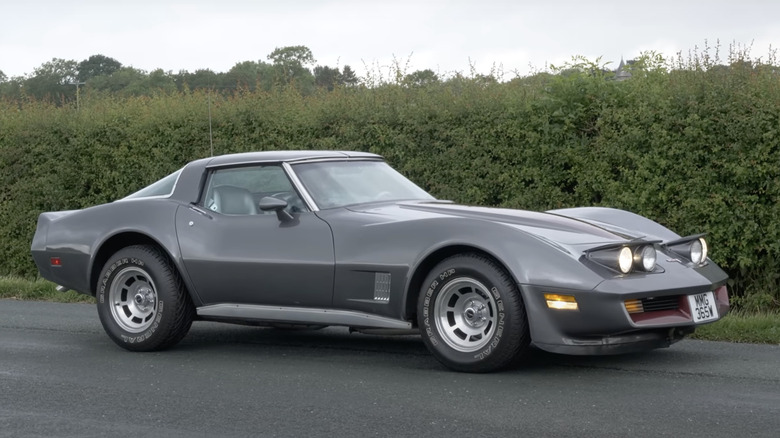4 Of The Slowest Corvettes With The Least Horsepower
The Corvette is an unquestioned American sports car icon, with a production run going back to the 1950s, and there were eight generations of Corvettes. Our list of the Chevrolets with the highest top speeds is dominated by Camaros and Corvettes, and a specially configured 2025 Corvette ZR1 hit a terminal velocity of 233 miles per hour during a recent track test in Germany. That was thanks to its 1,064-horsepower engine, which establishes a new standard for high-potency Chevy powerplants.
Not every Corvette has been a speed demon with a powerful engine, though. Although its design has remained consistently gorgeous throughout its long run, the Corvette has had its low points from a performance standpoint. Most of the Corvette models on this list were victims of circumstance — saddled with engines that were limited by the technology available at the time, governmental regulations, or both. If you want to find a used Corvette to take to your local racetrack, you'll probably want to stay clear of these pretty but pokey examples.
1953 and 1954 Corvettes were stuck with a 150 hp inline-six engine
When the first Corvettes were unveiled for the 1953 model year, they. were saddled with Chevy's Blue Flame inline six-cylinder engine that put out just 150 horsepower. For that year and the next, Corvettes moved about as well as pre-Golden Ticket Grandpa Joe from "Charlie and the Chocolate Factory." When Motor Trend tested the debut model, it took 11.5 seconds to amble from 0-60 miles per hour and topped out at a couple ticks past 105 miles per hour.
That 0-60 sprint would have the original 'Vette lagging a tiny bit behind Chevy's minivans from the early 1990s, although you'd look a lot cooler in a vintage Corvette than you would in a 1992 Lumina APV. Despite their unquestionably un-'Vette-like performance, examples from that first year in particular are precious for their timeless appeal and historical significance. Hagerty values a 1953 Corvette in good condition at $178,000 and the 1954 model at a more accessible but still steep $58,000.
The first V8 Corvette arrived in 1955
The Corvette got a big boost when Chevy's small-block V8s became available for the 1955 model year. '55 Corvette buyers could settle for the updated 155 horsepower Blue Flame inline-six or pony up for a 265 cubic inch V8 that produced 195 horsepower thanks to a Carter four-barrel carburetor, 8 to 1 compression ratio, and hi-lift cam. That was enough to shave the 0-60 time down to about 8.5 seconds.
While still nowhere near the capabilities of modern, fuel-injected Corvettes, that was at least on par with the acceleration of a 1990 Honda Prelude EX and more than two full seconds faster than the Blue Flame-powered model. Top speed for the '55 Corvette with the V8 was 120 miles per hour, which was plenty fast enough in the days when cars weren't even required to have seat belts. V8s would stay at the heart of the Corvette in various displacements through today, although the hybrid Corvette E-Ray adds an electric motor to power the front wheels.
The 1975 base model was emissions-restricted to 165 hp
Corvette engines continued to get more powerful in the late '50s and throughout the '60s, but when the 1970s came, a triple whammy hit American manufacturers of performance cars. The 1970 Clean Air Act began the process of phasing out leaded gasoline and mandating catalytic converters, the Middle Eastern Oil Producing and Exporting Countries (OPEC) placed an embargo on crude oil in 1973, and the U.S. Department of Transportation instituted Corporate Average Fuel Economy Standards in 1975. This led to the near-total extinction of the iron-and-steel American land yacht, but the relatively fit and trim Corvette was merely wounded by these developments. The 1975 model was powered by one of two versions of Chevy's stalwart 350 cubic inch V8, both of which were outfitted with four-barrel carburetors.
The tamer of the two engines produced 165 horsepower and took 9.6 seconds to get the 'Vette from 0-60 and 16.4 ticks to cover a quarter mile. The L82 Special engine option added a performance cam, upgraded heads with bigger valves, and some beefed-up internal components. This boosted output to 205 horsepower, but both of the 1975 350s were still held back by all the new emissions control add-ons.
1976-78 Corvettes still struggled
Over the next three years, the dynamometer and stopwatch weren't much kinder to the Corvette. As automakers fought to produce horsepower under the new government regulations, the standard-issue 350-inch V8 in the 1978 Corvette languished at 185 horses. That engine took 7.8 seconds to launch the 'Vette from 0-60, but the L82 Special was again available for buyers who weren't satisfied with those numbers. That option boosted output to 220 horsepower, thanks in part to the Rochester four-barrel carburetor.
Very little changed for the 1977 model year, leaving the Corvette as a beautifully sculpted machine but a relatively pedestrian performer. For 1978, the base engine lost five horsepower, but also available was the high-performance L82 series V8 that produced 220 horsepower and brought the Corvette back to respectability in terms of acceleration. The fastest 1978 variant was the Limited Edition Indianapolis 500 pace car version with the L82 engine that could sprint from 0-60 in just under eight seconds and topped out around 125 miles per hour.




